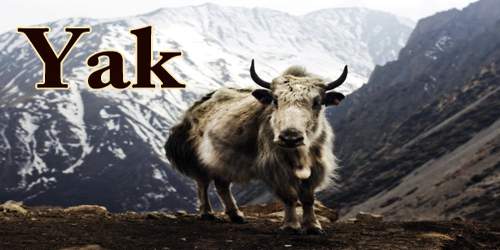The yak is a herd animal found in the mountainous regions of central Asia. It is a large shaggy ox with humped shoulders. It lives on high land, mostly in the part of China called Tibet. For centuries the people of Tibet have tamed yaks to use as work animals and as a source of food. The yak is related to cattle, buffalo, and bison. The domestic yak (Bos grunniens) is a long-haired domesticated bovid found throughout the Himalayan region of the Indian subcontinent, the Tibetan Plateau, Northern Myanmar, Yunnan, Sichuan and as far north as Mongolia and Siberia. The wild yak (Bos mutus) is a large wild bovid native to the Himalayas. In China, where they are known as “hairy cattle,” yaks are heavily fringed with long black hair over a shorter blackish or brown undercoat that can keep them warm to –40 °C (−40 °F). Color in domesticated yaks is more variable, and white splotches are common. Like bison (genus Bison), the head droops before high massive shoulders; horns are 80 cm (30 inches) long in the males, 50 cm in females.
The English word “yak” is a loan originating from Tibetan: གཡག་, Wylie: g.yag. In Tibetan and Balti it refers only to the male of the species, the female being called Tibetan: འབྲི་, Wylie: ‘bri or Tibetan: གནག, Wylie: g.nag in Tibetan and Tibetan: ཧཡག་མོ་, Wylie: hYag-mo in Balti. In English, as in most other languages that have borrowed the word, “yak” is usually used for both sexes, with “bull” or “cow” referring to each sex separately. It is not known with certainty when yaks were domesticated, although it is likely that they were first bred as beasts of burden for the caravans of Himalayan trade routes. Yaks’ lung capacity is about three times that of cattle, and they have more and smaller red blood cells, improving the blood’s ability to transport oxygen. Domesticated yaks number at least 12 million and were bred for tractability and high milk production. Yaks are also used for plowing and threshing, as well as for meat, hides, and fur. The dried dung of the yak is the only obtainable fuel on the treeless Tibetan plateau. The yak lives in cold places with few plants. Sometimes it has to roam a long way to find enough grass to eat. They have long shaggy hair that covers their bodies that keep them warm and dry. Yak also needs a lot of water. In winter it often eats snow.
Some yaks live in the wild, but they are very rare. Wild yaks have blackish-brown hair and large horns. Wild males may weigh up to 2,200 pounds (1,000 kilograms). Females are smaller. Wild yaks live in herds made up of females and young animals. Adult males live alone or in smaller groups. Domestic, or tamed, yaks are much smaller than wild yaks. They can be red, brown, black, or black and white. They have smaller horns than wild yaks. Some domestic yaks have no horns. The species was originally designated as Bos grunniens (“grunting ox”) by Linnaeus in 1766, but this name is now generally considered to refer only to the domesticated form of the animal, with Bos mutus (“mute ox”) being the preferred name for the wild species. Although some authors still consider the wild yak to be a subspecies, Bos grunniens mutus, the ICZN made an official ruling in 2003 permitting the use of the name Bos mutus for wild yaks, and this is now the more common usage. Except where the wild yak is considered as a subspecies of Bos grunniens, there are no recognized subspecies of yak. People use yaks for carrying and pulling heavy loads. Yaks are also kept for their meat and milk. The hair is used to make rope and cloth. The skin is used for caps, coats, and blankets.
















